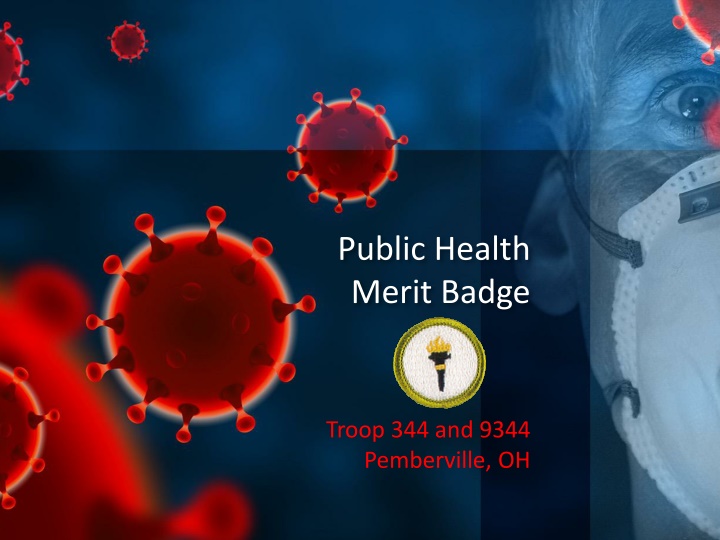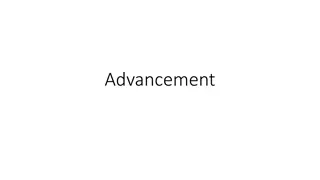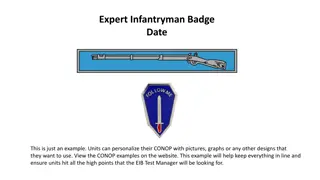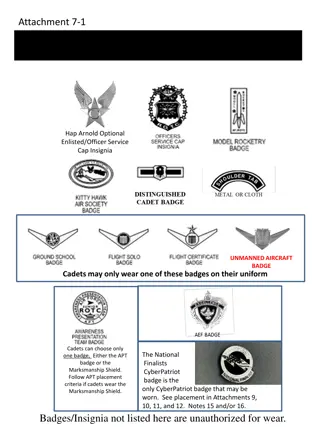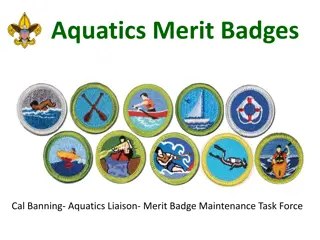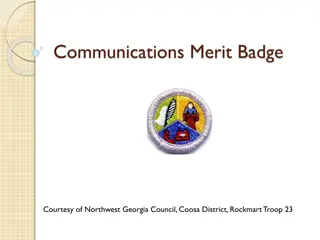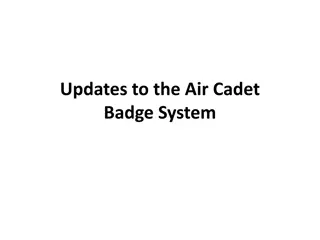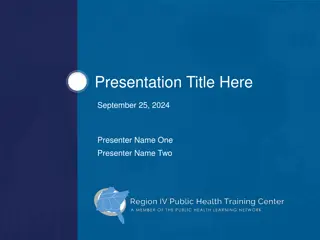Public Health Merit Badge Requirements Overview
Explore the Public Health Merit Badge requirements, covering topics such as disease transmission, immunization, safe drinking water, waste management, and food safety. Learn about various diseases, their prevention, and the importance of public health practices in keeping communities safe.
Uploaded on Aug 21, 2024 | 4 Views
Download Presentation

Please find below an Image/Link to download the presentation.
The content on the website is provided AS IS for your information and personal use only. It may not be sold, licensed, or shared on other websites without obtaining consent from the author.If you encounter any issues during the download, it is possible that the publisher has removed the file from their server.
You are allowed to download the files provided on this website for personal or commercial use, subject to the condition that they are used lawfully. All files are the property of their respective owners.
The content on the website is provided AS IS for your information and personal use only. It may not be sold, licensed, or shared on other websites without obtaining consent from the author.
E N D
Presentation Transcript
Public Health Merit Badge Troop 344 and 9344 Pemberville, OH
Public Health Requirements 1. Do the following: a. Explain what public health is. Explain how Escherichia coli (E. coli), tetanus, HIV/AIDS, malaria, salmonellosis, and Lyme disease are contracted. b. Choose any FOUR of the following diseases or conditions, and explain how each one is contracted and possibly prevented: gonorrhea, West Nile virus, Zika, botulism, influenza, syphilis, hepatitis, emphysema, meningitis, herpes, lead poisoning. c. For each disease or condition in requirement 1b, explain: 1. The type or form of the malady (viral, bacterial, environmental, toxin) 2. Any possible vectors for transmission 3. Ways to help prevent exposure or the spread of infection 4. Available treatments
Public Health Requirements 2. Do the following: a. Explain the meaning of immunization. b. Name eight diseases against which a young child should be immunized, two diseases against which everyone should be re- immunized periodically, and one immunization everyone should receive annually. c. Using the list of diseases and conditions in requirement 1b, discuss with your counselor those which currently have no immunization available.
Public Health Requirements 3. Discuss the importance of safe drinking water in terms of the spread of disease. Then, demonstrate two ways for making water safe to drink that can be used while at camp. In your demonstration, explain how dishes and utensils should be washed, dried, and kept sanitary at home and in camp. Explain what a vector is and how insects and rodents can be controlled in your home, in your community, and at camp. Tell why this is important. In your discussion, explain which vectors can be easily controlled by individuals and which ones require long-term, collective action. 4.
Public Health Requirements 5. With your parent's and counselor's approval, do ONE of the following: a. Visit a municipal wastewater treatment facility OR a solid- waste management operation in your community. 1. Describe how the facility safely treats and disposes of sewage or solid waste. 2. Discuss your visit and what you learned with your counselor. 3. Describe how sewage and solid waste should be disposed of under wilderness camping conditions.
Public Health Requirements 5. With your parent's and counselor's approval, do ONE of the following: b. Visit a food service facility, such as a restaurant or school cafeteria. 1. Observe food preparation, handling, and storage. Learn how the facility keeps food from becoming contaminated. 2. Find out what conditions allow micro-organisms to multiply in food, what can be done to help prevent them from growing and spreading, and how to kill them. 3. Discuss the importance of using a thermometer to check food temperatures. 4. Discuss your visit and what you learned with your counselor.
Public Health Requirements 6. Do the following: a. Describe the health dangers from air, water, and noise pollution. b. Describe health dangers from tobacco use and alcohol and drug abuse. c. Describe the health dangers from abusing illegal and prescription drugs. With your parent's and counselor's approval, do ONE of the following: a. Visit your city, county, or state public health agency. b. Familiarize yourself with your city, county, or state health agency's website. 7.
Public Health Requirements 8. After completing either 7a or 7b, do the following: a. Compare the four leading causes of mortality (death) in your community for any of the past five years with the four leading causes of disease in your community. Explain how the public health agency you visited is trying to reduce the mortality and morbidity rates of these leading causes of illness and death. b. Explain the role of your health agency as it relates to the outbreak of diseases. c. Discuss the kinds of public assistance the agency is able to provide in case of disasters such as floods, storms, tornadoes, earthquakes, and other acts of destruction. Your discussion can include the cleanup necessary after the disaster. Pick a profession in the public health sector that interests you. Find out the education, training, and experience required to work in this profession. Discuss what you learn with your counselor. 9.
Requirement 1 1. Do the following: a. Explain what public health is. Explain how Escherichia coli (E. coli), tetanus, HIV/AIDS, malaria, salmonellosis, and Lyme disease are contracted. b. Choose any FOUR of the following diseases or conditions, and explain how each one is contracted and possibly prevented: gonorrhea, West Nile virus, Zika, botulism, influenza, syphilis, hepatitis, emphysema, meningitis, herpes, lead poisoning. c. For each disease or condition in requirement 1b, explain: 1. The type or form of the malady (viral, bacterial, environmental, toxin) 2. Any possible vectors for transmission 3. Ways to help prevent exposure or the spread of infection 4. Available treatments
Requirement 1a What is Public Health? Public health is the science of protecting and improving the health of people and their communities. This work is achieved by promoting healthy lifestyles, researching disease and injury prevention, and detecting, preventing and responding to infectious diseases.
Requirement 1a Knowing how diseases can be spread is key to prevention. Aerosol/droplets Direct contact Contaminated water Contaminated food Vectors (Organisms which carry and transmit an infectious pathogen into another living organism.)
Requirement 1a Escherichia coli (E. coli) E. coli is one of the most common bacteria found in human and animal digestive systems It s benefits to us include the production of vitamin K (helps blood clotting) and by preventing other dangerous germs to grow in our guts.
Requirement 1a Escherichia coli (E. coli) However, some strains can produce toxins that can make us sick or cause death. Occasionally during food preparation our food becomes contaminated with bad E. coli. If the food is not cooked properly, we ingest these germs and they cause illness. They can also be acquired by swallowing contaminated swimming water.
Requirement 1a Pathogenic E. coli Type or Form Bacteria Method of Transmission or Vectors Eating food contaminated with animal feces. No animal vectors. Wash your hands thoroughly before preparing food!! Wash vegetable produce before serving. Keep meats away from foods that won t be cooked. Cook ground or tenderized meats to an internal temperature of 160oF. Methods of Prevention Supportive care, including hydration. Antibiotics and anti-diarrheal drugs should not be used as they increase the risk of complications. Available Treatments
Requirement 1a Tetanus Also known as lockjaw, is caused by a toxin produced by the bacteria Clostridium tetani. C. tetani is a common environmental bacteria found in soil, especially current or former farm lands. Characteristic symptoms include sever muscle pain and stiffness, difficulty swallowing, muscle spasms (strong enough to break bones).
Requirement 1a Tetanus Commonly associated with rusty nails. It is not the rust that causes tetanus, but the dirt and low oxygen environment of the rust that provides a place for the germs to hide. 10% to 20% of those infected die.
Requirement 1a Tetanus Type or Form Bacteria Method of Transmission or Vectors Puncture wounds from dirty objects. No animal vectors. Vaccination available. Booster shots every 10 years for adults. If you suffer a deep puncture wound, apply appropriate first-aid and follow up with a doctor. Wear shoes! Methods of Prevention Available Treatments Tetanus antitoxin. Antibiotics.
Requirement 1a HIV/AIDS Caused by the Human Immunodeficiency Virus. The virus replicates itself inside the human white blood cells responsible for controlling our immune systems. When the virus destroys enough cells over time, our immune system fails. Patients become very susceptible to opportunistic infections.
Requirement 1a Main Symptoms of Acute HIV Infection
Requirement 1a HIV/AIDS Type or Form Virus Method of Transmission or Vectors Direct contact with human bodily fluids. No animal vectors. Safe sex practices or abstinence. Don t use illicit drugs. Substance abusers should take advantage of needle exchange programs. Health care workers need to wear personal protection equipment. Testing of blood/organs before transfusion/transplants. Methods of Prevention No vaccine, no cure. Antiviral drugs can slow progress of disease. Treatment of opportunistic infections. Available Treatments
Requirement 1a Malaria is a mosquito-borne disease caused by a parasite. People with malaria often experience fever, chills, and flu-like illness. Left untreated, they may develop severe complications and die. In 2018 an estimated 228 million cases of malaria occurred worldwide and 405,000 people died, mostly children in the African Region. About 2,000 cases of malaria are diagnosed in the United States each year. The vast majority of cases in the United States are in travelers and immigrants returning from countries where malaria transmission occurs.
Requirement 1a Malaria Type or Form Parasitic protozoan (Plasmodim sp.) Method of Transmission or Vectors Mosquitoes Control mosquitoes. Use insect repellant with DEET. Sleeping under mosquito netting. Antimalarial medicines can also be used to prevent malaria. Methods of Prevention Available Treatments Antimalarial medicines.
Requirement 1a Salmonellosis Caused by the bacteria Salmonella. Infection occurs by ingesting food products contaminated with Salmonella Symptoms occur 12 to 72 hours after consuming contaminated food and includes vomiting and diarrhea. In children, elderly, and persons with weakened immune systems, severity of the infection can cause death. Contamination usually occurs during food handling and preparation. The bacteria are common on reptiles, amphibians, rodents, and birds (chicken).
Requirement 1a Salmonella Type or Form Bacteria Method of Transmission or Vectors Eating foods contaminated with feces from an infected animal. No animal vectors. Wash your hands thoroughly before preparing food!! Wash vegetable produce before serving. Keep meats away from foods that won t be cooked. Cook ground or tenderized meats to an internal temperature of 160oF. Methods of Prevention Supportive care, including hydration. Antibiotics and anti-diarrheal drugs should not be used as they increase the risk of complications. Available Treatments
Requirement 1a Lyme Disease Caused by bacteria transmitted by the deer tick. Symptoms can include chills and fever, headache, fatigue, stiff neck, muscle and/or joint pain, and swollen glands. A bull s eye rash is typical in many cases.
Requirement 1a Lyme Disease Type or Form Bacteria Method of Transmission or Vectors Deer Tick (Ixodes scapularis) Also called Blacklegged Tick In tick areas: Wear light colored clothing. Use insect repellents with DEET. Check your body for ticks and remove within 24 hours. Know how to properly remove a tick if you are bitten. Methods of Prevention Available Treatments Antibiotics
Requirement 1a Nymph ticks are actually the most likely to transmit Lyme disease or another tick-borne infection to humans than ticks at other stages. Less than two millimeters in size, nymphs can bite people and remain virtually undetected.
Requirement 1 1. Do the following: a. Explain what public health is. Explain how Escherichia coli (E. coli), tetanus, HIV/AIDS, malaria, salmonellosis, and Lyme disease are contracted. b. Choose any FOUR of the following diseases or conditions, and explain how each one is contracted and possibly prevented: gonorrhea, West Nile virus, Zika, botulism, influenza, syphilis, hepatitis, emphysema, meningitis, herpes, lead poisoning. c. For each disease or condition in requirement 1b, explain: 1. The type or form of the malady (viral, bacterial, environmental, toxin) 2. Any possible vectors for transmission 3. Ways to help prevent exposure or the spread of infection 4. Available treatments
Requirement 1b Gonorrhea Type or Form Bacteria Sexually transmitted disease (STD). No animal vectors. Method of Transmission or Vectors Methods of Prevention Abstinence Safe sex practices Available Treatments Antibiotics
Requirement 1b West Nile Virus Type or Form Virus Method of Transmission or Vectors Mosquitoes transmit virus from birds. Eliminate stagnant water sources. Use insect repellent Methods of Prevention No disease treatment. Supportive care. Available Treatments Symptoms and signs of West Nile virus include fever, headache, body aches, skin rash, and swollen lymph nodes. Most cases of West Nile virus infection are mild and go unreported.
Requirement 1b In most cases, there are no symptoms. In a few cases, Zika can trigger paralysis (Guillain-Barr Syndrome). In pregnant women, it may cause subsequent birth defects. When present, symptoms are mild and last less than a week. They include fever, rash, joint pain, and red eyes. Zika Type or Form Virus Method of Transmission or Vectors Mosquitoes Eliminate stagnant water sources. Use insect repellent Methods of Prevention No disease treatment. Supportive care. Available Treatments
Requirement 1b Botulism Type or Form Bacteria toxin Food borne botulism: Humans come into contact with botulism by eating improperly canned or preserved foods that contain the botulinum toxin. Wound botulism : Humans come into contact with botulism when a wound is infected with bacteria. No animal vectors. Method of Transmission or Vectors Safe food handling. Proper wound care. Methods of Prevention Antitoxin Supportive care Antibiotics Available Treatments
Requirement 1b Influenza Type or Form Virus Method of Transmission or Vectors Person-to-person Aerosol/droplet. No animal vectors. Methods of Prevention Hand washing. Social distancing. Supportive care. Antiviral therapies. Available Treatments Every year in the United States, on average: 5% to 20% of the population gets the flu. More than 200,000 people are hospitalized from flu-related complications. About 36,000 people die from flu-related causes.
Requirement 1b Corona Virus Type or Form Virus Method of Transmission or Vectors Person-to-person. Aerosol/droplet. No animal vectors. Methods of Prevention Hand washing. Social distancing. Available Treatments Supportive care. The coronavirus (COVID-19), causes severe acute respiratory problems. The World Health Organization declared the outbreak a pandemic on March 11, 2020. As of May 19, 2020, more than 4.86 million cases of COVID-19 have been reported in more than 188 countries and territories, resulting in more than 321,000 deaths. More than 1.66 million people have recovered from the virus.
Requirement 1b Syphilis Type or Form Bacteria Method of Transmission or Vectors Sexually transmitted disease (STD). No animal vectors. Methods of Prevention Abstinence. Safe sex practices. Available Treatments Antibiotics.
Requirement 1b Hepatitis Type or Form Viruses Method of Transmission or Vectors Blood borne pathogen. Foodborne illness. No animal vectors. Blood and body fluid precautions. Proper food handling/hygiene. Vaccination. No animal vectors. Hepatitis refers to an inflammatory condition of the liver. It's commonly caused by a viral infection, Methods of Prevention Antiviral therapies. Supportive care. Available Treatments
Requirement 1b Emphysema Type or Form Environmental Chronic exposure to toxic chemicals such as long-term smoking. No animal vectors. Method of Transmission or Vectors Don t smoke. Avoid second-hand smoke. Methods of Prevention No cure. Supportive/comfort care until death. Lung transplants. Available Treatments
Requirement 1b Meningitis Type or Form Bacteria or virus Method of Transmission or Vectors Person-to-person. No animal vectors. Methods of Prevention Vaccination. Isolation/quarantine. Bacterial Antibiotics. Viral Usually self- limiting*. Supportive care. Available Treatments *Self-limiting: They last a while and then go away as your body fights them.
Requirement 1b Herpes Type or Form Virus Sexually transmitted disease (STD). Maternal to infant. No animal vectors. Method of Transmission or Vectors Methods of Prevention Abstinence. Safe sex. No cure. Antivirals to control outbreaks. Available Treatments
Requirement 1b Lead Poisoning Type or Form Environmental Environmental exposure (usually ingestion by infants/toddlers). No animal vectors. Method of Transmission or Vectors Lead Paint Environmental monitoring. Abatement (Eliminate and remove lead based paint). Identification of at risk persons. Methods of Prevention Available Treatments Chelation therapy
Requirement 2 2. Do the following: a. Explain the meaning of immunization. b. Name eight diseases against which a young child should be immunized, two diseases against which everyone should be re-immunized periodically, and one immunization everyone should receive annually. c. Using the list of diseases and conditions in requirement 1b, discuss with your counselor those which currently have no immunization available.
Requirement 2a Immunization is the process whereby a person is made immune or resistant to an infectious disease, typically by the administration of a vaccine. Vaccines stimulate the body's own immune system to protect the person against subsequent infection or disease.
Requirement 2 2. Do the following: a. Explain the meaning of immunization. b. Name eight diseases against which a young child should be immunized, two diseases against which everyone should be re-immunized periodically, and one immunization everyone should receive annually. c. Using the list of diseases and conditions in requirement 1b, discuss with your counselor those which currently have no immunization available.
Requirement 2b Recommended Immunization Schedule 2020
Requirement 2 2. Do the following: a. Explain the meaning of immunization. b. Name eight diseases against which a young child should be immunized, two diseases against which everyone should be re-immunized periodically, and one immunization everyone should receive annually. c. Using the list of diseases and conditions in requirement 1b, discuss with your counselor those which currently have no immunization available.
Requirement 2c Diseases for which there is currently no vaccine. Gonorrhea West Nile Virus Zika Botulism Syphilis Emphysema Herpes Lead Poisoning
Requirement 3 3. Discuss the importance of safe drinking water in terms of the spread of disease. Then, demonstrate two ways for making water safe to drink that can be used while at camp. In your demonstration, explain how dishes and utensils should be washed, dried, and kept sanitary at home and in camp.
